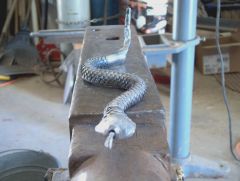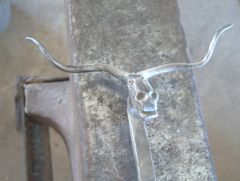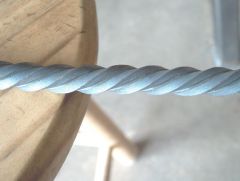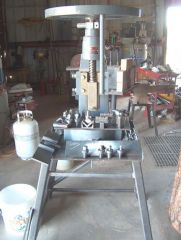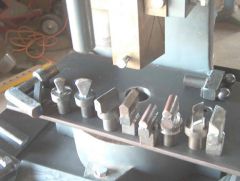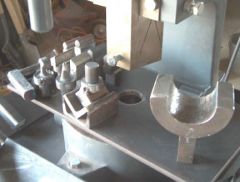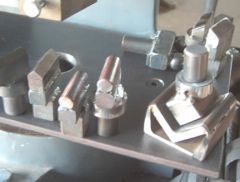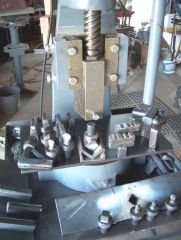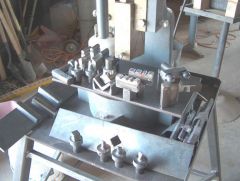-
Posts
130 -
Joined
-
Last visited
Content Type
Profiles
Forums
Articles
Gallery
Downloads
Events
Everything posted by Ellen
-
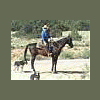
Something different (horseshoe)
Ellen replied to Mike Turner's topic in Blacksmithing, General Discussion
Not counting forge and anvil, the basic shoeing tools of good quality will set you back around $500. Hoof nippers will set you back $150 or more. If you want to keep your farrier you will work with your horse(s) every day; pick up their feet, pick the hoofs, put the foot in shoeing position while you are working on each one, make sure to hold each foot up around 2 to 3 minutes. You will also be there when your horse is shod, generally holding the lead rope, and doing whatever necessary to keep your horse well behaved. It helps if you make a few items now and then for small gifts for your farrier. And pay him on completion of the job. Cash is nice. Take good care of your horses (farriers generally have a soft spot in their hearts for the well being of horses), keep the area clean. Have the horse groomed and fly sprayed before the farrier arrives. Small things that make a big difference. And they are also the right things to do for your horse. If you're not willing to care for them, don't have 'em. -
I get the Cleveland Twist drills from MSC. HSS is adequate for me, but I run my drill press at lower speeds and keep the drill lubed, so heat build up is not a problem.
-

Something different (horseshoe)
Ellen replied to Mike Turner's topic in Blacksmithing, General Discussion
"There is another saying that goes like this. Most farriers make good blacksmiths but not all blacksmiths make good farriers." Great horseshoe Mike. I have smithed a few years and also have the privlege of owning horses. I have a cabin in NM which is kinda remote, so if I am up there for a few weeks in the summer and my horse loses a shoe, I have no choice but to put one on or trailer him a goodly distance to have it done, so I have learned to put one on. I can assure you that every time "I put one on" I bless my farrier in town and envy his skill. I have made a few (very plain) horseshoes just for the fun of it, and that is easy compared to: A: holding the hoof to work on B. triming the hoof without laming your horse c. nailing the new shoe on (fitting is easy) I can also say that to have to tools to do this will set you back a lot more than you pay your farrier for several shoeings (not counting the forge and anvil). So, farriers should be appreciated more by blacksmiths, and we should have a great appreciation of those "jack of all trades" smiths from yesteryear. -
Nice. For those who haven't done the math 15Kg is 33 pounds. Take an ox to swing it.....more than once! I've found since I acquired a blown 3 burner propane forge I am able to soak and heat bigger objects, my welds are much better, and it's is easy to control the atmosphere from reducing to oxidizing.
-
Jim, I had to "start over" a few years back, and.......it was the best thing that ever happened to me. I eventually went from a 14 X 14 shop to a 40 X 60 shop, with an Iron Kiss 115# air hammer and loads of other goodies. Life is better for me in every way. I also had to beat cancer along the road, and all things combined I live each day with a whole new perspective on how good life can be.....it just takes a tad of stubborness and knowing what you want.....and you have me trumped in those departments by far. You will be just fine, give it a few months and you'll be doing better than ever. My "summer place" in Catron County NM is populated by 2700 souls according to last census, and I love it there! Apache Junction where I live now is a town of less than 40,000, which in Arizona is sparsely populated.
-
Jim, sorry to hear of your troubles. Best wishes for you to land on your feet, better than ever. Wish I was close enough to help you move!
-
You're going to get a hundred different answers on this one, so I all I can tell you is what works for me. 1. I like to clean the scale or mill finish off the metal and prepare the surface, sometimes it needs to be scarfed or bumped up. 2. I like to wire together with soft wire, it melts at a higher temperature than steel with more carbon in it so it will hold the two separate pieces together, of course if folding a piece of sell over on itself this is not necessary and that is probably the best for a first weld anyway. 3. Bring to a red heat and flux. 4. Flux: lots of folks use plain old 20 mule team team borax available in 5# boxes in the laundry section of most supermarkets. Others swear by or at: Anti Borax #1 (from just about any welding supply house or online from PiehTooCo.com or Blacksmiths Depot.com)--this is basically solid boric acid crystals with iron filings, I like it it a lot; "Sureweld", and other trade name welding fluxes available from the online suppliers. 5. Bring to a welding heat (this is the tricky part, judging the heat); it can be anything from a "slippery orange" to a bright white just short of throwing sparks; tap lightly to start the weld, return to the fire as soon as welding heat is lost, reheat and repeat. As the metal welds together you can hit it harder. Like I say, there's lot of different opinions on this....good luck!
-
Its been said so often it sounds like a cliche, but it remains true: the price of freedom is vigilence. In our case(s) that means being registered to vote, knowing where candidates stand on issues, and voting your beliefs. Nothing else you can do takes the place of being an informed voter.
-
I have a canvas outdoors vest, didn't cost much, lightweight with a mesh back for our desert temperatures; in the many pockets I have my survival items pretty much as Coyote Sore Belly Bob described, plus a whistle and a mirror, a magnesium "fire stick", and I carry it behind the seat in my pick up. When I stop someplace to take a hike around I slip the vest on and have all my gear. This was a tip from the Hunter Safety Class, and a good one.
-

Oil Quenchant for Heat Treating
Ellen replied to Graham Fredeen's topic in Heat Treating Knives, Blades etc
35# of new soybean oil at Sam's Club for $13. That's about 5 gallons. Works great, no smell, much higher flash point than most other oils. Yes, you still need to temper the blade. The kitchen oven at 350 to 400F, depending on your desired result and starting steel works great. You'll be glad it's not used cooking oil when you temper the blade inside the house. Make sure you buy the pure oil, some of the frying oils have additives in them and I am not sure how that will affect the quenching results. Use a large enough quantity of oil for the blade, stir in a figure 8 pattern, pull the blade out when is cooled to a black heat, and let it air cool, then temper it in the over. The air cool from a black heat to a "hold in your hand heat" will give you about 15 minutes of crucial time for the transformation of the martensite in the blade steel and will eliminate the need to "triple temper" the blade. I've used this technique on O-1, 1095, and 5160. -
Thomas D., I hope things improve on the visitiation front. Sometimes new mothers are a tad possessibe (instinct?), and they learn to let go after a few weeks. 2 AM feedings are good in this direction! It may be that she will shortly see the benefits of having loving grandparents available so she can grab a bit of rest. I would advise sweetness and light for a bit and see what happens. Rewards come most often to those with patience. INMHO, anyway. Good luck!
-
911 is government sponsored dial-a-prayer. Most urban areas of the USA average 20 minutes and up for a response time. That can be way too long in lots (most?) of situations. If you can't be safe and knowledgeable, don't use the process. That is the beauty of vinegar. It is safer than the other chemicals; you can heat it up a bit if you want faster.
-
Ten Hammers, long time since I studied physics but as I recall, Boyle's Law(s) which cover the behavior of gasses show that volume is inversely related to pressure; i.e. pressure goes up, volume goes down. A practical example of this is a coal forge blower which moves a larger volume of air at a low pressure and works well, vs. trying to manage a coal fire with an air compressor which produces a higher pressure and a lower volume. Sorry if my explanation is not clear, perhaps others can be more lucid on the topic.
-

Moving Heavy Stuff...what to buy in what order
Ellen replied to Matthew Groves's topic in Shop Tips n' Tricks
I use my tractor and front end load for moving a lot of things but it is too big to maneuver inside most shops.....but, you can pick something up with it, put it on a pallet, and a pallet jack (hydraulic with wheels) will move a lot of stuff. The practical limit of a tractor's front end load is probably about 2,000 # for a medium sized tractor. I have a 3,000# power hammer on order and I am just going to have the trucking company take it straight to a rigging yard and they will bring it out and install it. Maybe I could do it.....but the pros have insurance....grin! -
Dodge, I think you've got it!
-
Rick, I start with a basic horsehead and add something to it, like for a towel bar (with twists), a coat hanger, or a hat hanger. The longhorn head can be replaced with a simple hook, a 1/4 sq with a twist works nice and is a lot quicker, that lets you keep the price down to $20 to $30....

